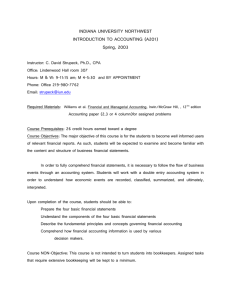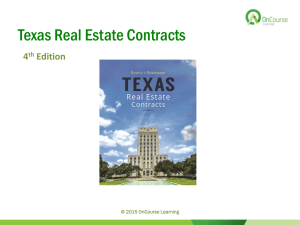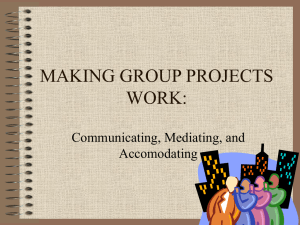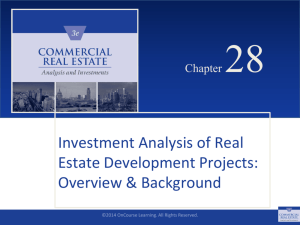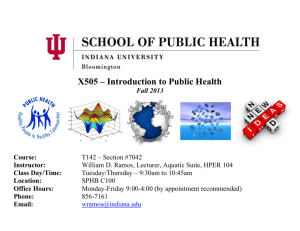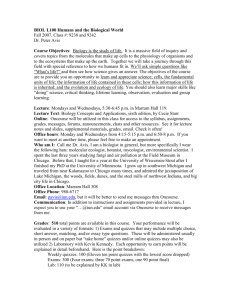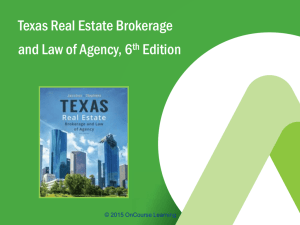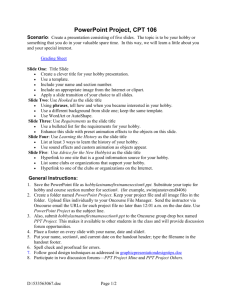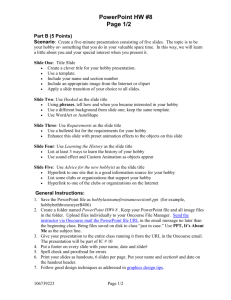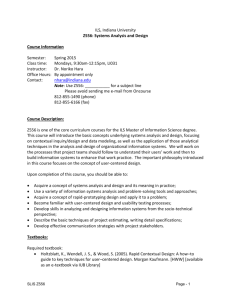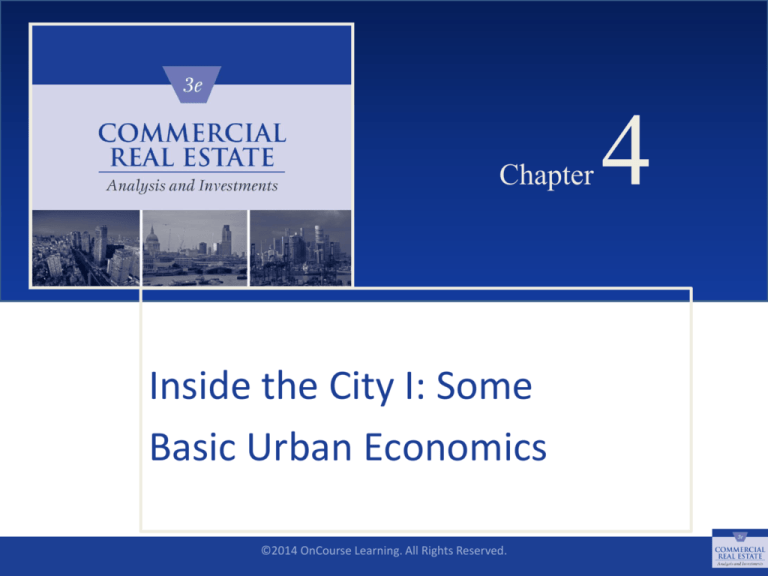
CHAPTER
4
Chapter
Inside the City I: Some
Basic Urban Economics
SLIDE 1
©2014 OnCourse Learning. All Rights Reserved.
4
CHAPTER
4
CHAPTER OUTLINE
A Threshold Concept: Urban Form
4.1 Some Basic Economic Principles of Urban Land Value and Use
4.1.1
4.1.2
4.1.3
4.1.4
Location and the Residual Nature of Land Value
Competition, Equilibrium, and Highest and Best Use
Role of Transport Costs: The Bid-Rent Curve
Summary of Basic Urban Land Value and Land Use Principles
4.2 Classic Monocentric City Model
4.2.1 Circlopolis, the Quintessential Monocentric City
4.2.2 Using the Model: Some Principles about How Rents and City Size
Change
4.2.3 Summarizing the Monocentric Model
4.3 Chapter Summary
SLIDE 2
©2014 OnCourse Learning. All Rights Reserved.
CHAPTER
4
LEARNING OBJECTIVES
After reading this chapter, you should understand:
What determines land rents in a city.
Why and how a freely functioning, competitive land
market will lead to land being used at its “highest
and best use” (i.e., most productive use).
What determines the relative land values at different
locations within a city and the relative growth rate of
these values at different locations.
SLIDE 3
©2014 OnCourse Learning. All Rights Reserved.
CHAPTER
4
A Threshold Concept: Urban Form
SLIDE 4
©2014 OnCourse Learning. All Rights Reserved.
4.1 Some Basic Economic Principles of Urban
Land Value and Use
SLIDE 5
©2014 OnCourse Learning. All Rights Reserved.
CHAPTER
4
4.1.1 Location and the Residual Nature of Land
Value
SLIDE 6
©2014 OnCourse Learning. All Rights Reserved.
CHAPTER
4
4.1.2 Competition, Equilibrium, and Highest
and Best Use
SLIDE 7
©2014 OnCourse Learning. All Rights Reserved.
CHAPTER
4
CHAPTER
4
© OnCourse Learning
EXHIBIT 4-1 Highest and Best Use Example
SLIDE 8
©2014 OnCourse Learning. All Rights Reserved.
4.1.3 Role of Transport Costs: The Bid-Rent
Curve
SLIDE 9
©2014 OnCourse Learning. All Rights Reserved.
CHAPTER
4
© OnCourse Learning
EXHIBIT 4-2 Bid-Rent Functions of Three Land Uses
with Differing Productivity and Sensitivity to
Transport Cost
CHAPTER
4
SLIDE 10
©2014 OnCourse Learning. All Rights Reserved.
4.1.4 Summary of Basic Urban Land Value and
Land Use Principles
SLIDE 11
©2014 OnCourse Learning. All Rights Reserved.
CHAPTER
4
CHAPTER
4
4.2 Classic Monocentric City Model
SLIDE 12
©2014 OnCourse Learning. All Rights Reserved.
4.2.1 Circlopolis, the Quintessential
Monocentric City
SLIDE 13
©2014 OnCourse Learning. All Rights Reserved.
CHAPTER
4
CHAPTER
4
© OnCourse Learning
EXHIBIT 4-3 Cross-Section of Real Property
Rents in Circlopolis and Agricolia
SLIDE 14
©2014 OnCourse Learning. All Rights Reserved.
4.2.2 Using the Model: Some Principles about
How Rents and City Size Change
SLIDE 15
©2014 OnCourse Learning. All Rights Reserved.
CHAPTER
4
© OnCourse Learning
EXHIBIT 4-4 Effect of Population Growth with
Density and Transport Cost Constant
CHAPTER
4
SLIDE 16
©2014 OnCourse Learning. All Rights Reserved.
© OnCourse Learning
EXHIBIT 4-5 Effect of Population Growth with
Area Constant
CHAPTER
4
SLIDE 17
©2014 OnCourse Learning. All Rights Reserved.
© OnCourse Learning
EXHIBIT 4-6 Effect of Transport Cost Reduction
Savings Applied to Greater Purchase of Land
CHAPTER
4
SLIDE 18
©2014 OnCourse Learning. All Rights Reserved.
© OnCourse Learning
EXHIBIT 4-7 Effect of Transport Cost Reduction
Savings Not Applied to Purchase of Land
CHAPTER
4
SLIDE 19
©2014 OnCourse Learning. All Rights Reserved.
CHAPTER
4
4.2.3 Summarizing the Monocentric Model
SLIDE 20
©2014 OnCourse Learning. All Rights Reserved.
CHAPTER
4
4.3 Chapter Summary
SLIDE 21
©2014 OnCourse Learning. All Rights Reserved.
CHAPTER
4
KEY TERMS
urban form
transportation cost
minimized
residual theory of land monocentric city
value
radius to the urban
boundary
mobile factors
agricultural rent
highest and best use
(HBU)
construction cost rent
bid-rent curve (function) rent gradient
central point
location rent (location
premium)
factor of production
SLIDE 22
©2014 OnCourse Learning. All Rights Reserved.

